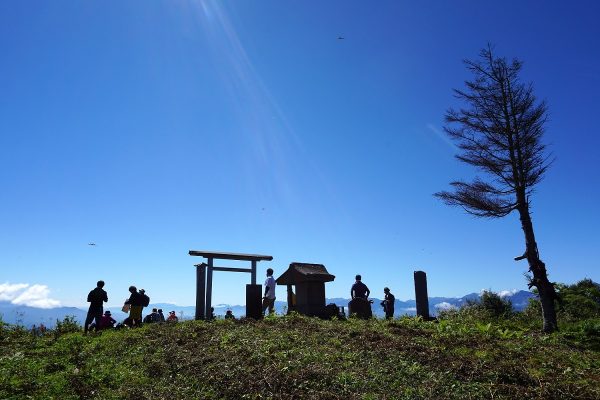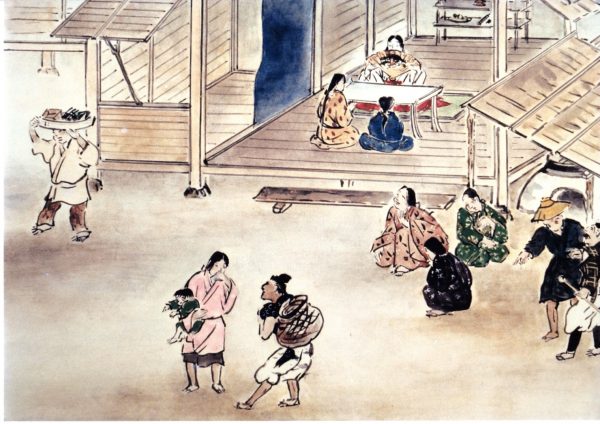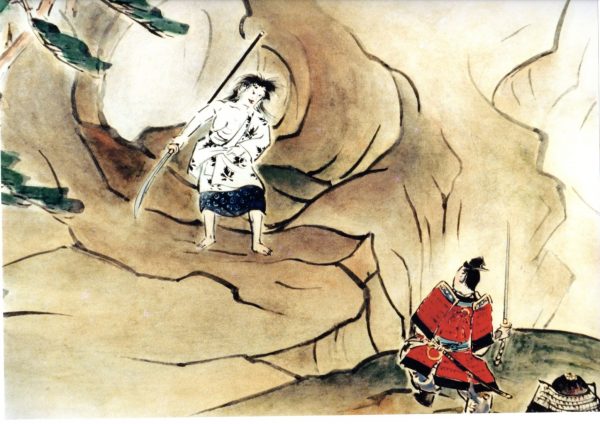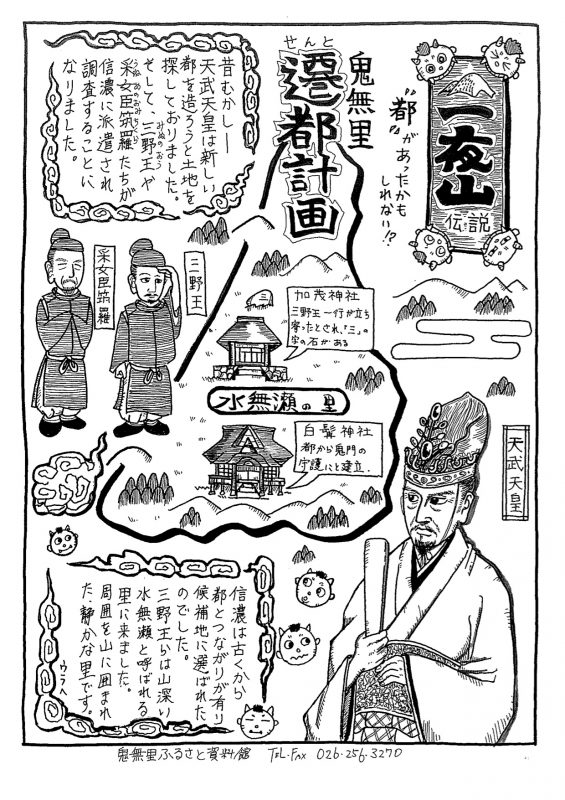We have different local legends about the origin of the name “Kinasa”, which means “village without an evil spirit.” The two most widely known are the story of Kijo-Momiji and the story of the demons who created Mt. Ichiya-san to prevent the capital being relocated here from Kyoto. There are many other legends and folk tales such as the story of General Yoshinaka Kiso who became famous in the late Heian period of Japanese history and Juni Shrine, where the remains of a mooring post tell us the shrine grounds were once the bottom of a lake.
・The Legend of Kijo-Momiji
The legend of the origin of the name, Kinasa
Click here>> (English follows Japanese.)
Long time ago, there were an old couple. They prayed to the spirit in the heaven for giving them a baby. And they had a girl, who was named Kureha. She was so beautiful and clever. When she came of age, her family moved to Kyoto and opened a shop. Kureha changed her name to Momiji and started practicing the Koto (a Japanese harp).
One day, lord Minamoto-no-Tsunemoto and his wife heared Momiji’s playing Koto and invited her to their home. Her beauty fascinated Tsunemoto. They began to love each other and Momiji got pregnant. She wanted his love all to herself and tried to kill his wife. However, it was not succeeded. She was arrested and banished from Kyoto to Minase in Shinano, Nagano prefecture.
When she arrived at Minase village, she told people that she was banished because Tsunemoto’s wife felt jealous of her. People felt sorry and built a house for her. She was pleased and used her witchcraft for giving a cure to the sick people in the village.Still, she missed Kyoto so much and she named neighbor villages as same as Kyoto, such as Higashikyo, Nishikyo, Nijo and Sanjo.
Momiji had a baby boy and she wanted her son to see Tsunemoto. In order to make money for going back to Kyoto, she robbed and took money for many villages by force. Her criminal act came to the Emperor’s notice. The Emperor gave a command and let General Taira-no-Koremochi attack her.
The war began. However, because of Momiji’s witchcraft, Koremochi’s army were made themselves powerless. Koremochi prayed to the god for help and was given a sword The sword made her magical powor ineffective. She got on a cloud and running away. Koremochi released the sword from a bow. It stuck in her chest and she died. She was 33 years old. It was a very beautiful day in autumn.
After that, people began to call this village “Kinasa” , which means a village without evil spirit. (from a folktale in Kinasa)
(Prepared by Kinasa furusato museum)
Model course
The course indicate places associated with the Kijo-Momiji such as Shoganji Temple and the Site of Dairiyashiki. Click here to see the details.
・The Story of the Demons who made Mt. Ichiya-san
Along with the legend of Kijo-Momiji, this legend is said to be the origin of the name, Kinasa.
Around the year 684, Emperor Tenmu was making plans to move the capital to Shinano Province. An official was sent to investigate this area, called Minase at the time. The demons decided to build a mountain overnight to prevent the capital from being built, which enraged Emperor Tenmu, and he drove them all off. That is how the name of the village changed from Minase, which means “water flows beneath the ground but the ground is dry,” to a “town without demons,” or Kinasa. The mountain that the demons built overnight is called Mt. Ichiya-san, which means “one-night mountain,” and now it is a hiking course geared toward beginner hikers.

General Yoshinaka Kiso
In the late Heian period, Minamoto-no-Yoshinaka (better known as Yoshinaka Kiso) was called to the north to defeat the Taira’s, and it is said he passed through Kinasa in 1183 on his way there. At that time, Yoshinaka left his guardian Boddhisatva statue there, but as he died before he could ever return, his retainers built Tsuchikura Monjudo Temple and enshrined his Boddhisatva statue there. Monjudo Temple still stands in Kinasa today. After Yoshinaka’s passing, his retainers attempted to hide his son, Rikijumaru in a cave opening in a cliff that still exists in Okususobana Valley (currently the roads are poor and unpassable). Those in Kinasa with the surnames of Imai or Higuchi are said to be the descendants of the Yoshinaka retainers who settled there.

The story of the dried up lake

There is a zelkova tree called the “Mooring Tree” at Juni Shrine in the Nakata area, which is near the Togakushi border. It is said that in ancient times, Kinasa sat at the bottom of a lake. The Mooring Tree connected a ferry that ran from the southwest corner of Juni Shrine to Iizuna Shrine (now the summit of Mt. Iizuna in Ogawa Village), which is a distance of 7.5 meters away if you travel in a straight line. At a certain point in time, a landslide took place that allowed the water to flow out from the lake near the area where the Choshiguchi tunnel sits on what is now Route 406. The bottom of the lake revealed the land known today as Kinasa, and at the time it was called Minase. One of the mountains that appeared at the bottom of the lake is said to be Mt. Uo, which is near Kinasa Shrine. Lending some credit to this story is the fact that the crest of Juni Shrine is a sailing ship, and the torii gate is called Namiyoke torii, which means “protection against waves.”





